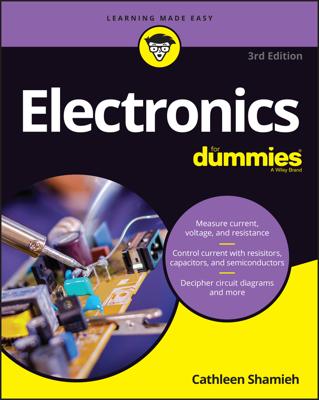You can measure resistance of an electronic circuit using an ohmmeter, which is a standard feature found in most multimeters. The procedure is simple: First, you disconnect all voltage sources from the circuit; then, you touch the ohmmeter's two probes to the ends of the circuit and read the resistance (in ohms) on the meter.
Resistance is measured in units called ohms, represented by the Greek letter omega (Ω). The standard definition of one ohm is simple: It's the amount of resistance required to allow one ampere of current to flow when one volt of potential is applied to the circuit. In other words, if you connect a one-ohm resistor across the terminals of a one-volt battery, one amp of current will flow through the resistor.
A single ohm (1 Ω) is actually a very small amount of resistance. Resistances in the hundreds, thousands, or even millions of ohms are usually called for in electronic circuits.
Here are a few other points to consider about resistance and ohms:
The abbreviations k (for kilo) and M (for mega) are used for thousands and millions of ohms. Thus, a 1,000-ohm resistance is written as 1 kΩ, and a 1,000,000-ohm resistance is written as 1 MΩ.
For the purposes of most electronic circuits, you can assume that the resistance value of ordinary wire is zero ohms (0 Ω). In reality, however, only superconductors have a resistance of 0 Ω.
Even copper wire has some resistance. Because of that, the resistance of wire is usually measured in terms of ohms per kilometer or per mile. Electronic circuits usually deal with wires that are at most a few inches or feet long, not kilometers or miles.
Short circuits also have essentially zero resistance.
Just as ordinary wire and short circuits can be considered to have zero resistance, insulators and open circuits can be considered to have infinite resistance, and in reality, there's no such thing as completely infinite resistance.
If you connect two wires to the terminals of a battery and hold the wires apart, a voltage difference exists between the ends of those two wires, and a very small current will travel between them — even through the air because air doesn't have infinite resistance.
This current is extraordinarily small — too small to even measure — but it's there nonetheless. Electric currents are literally everywhere.
The unit ohm is named after the famous German physicist Georg Ohm, who was the first to explain the relationship between voltage, current, and resistance in 1827.
Actually, the discovery was first made by a British scientist named Henry Cavendish more than 45 years earlier, but Cavendish never published his work. If he had, resistance would be measured in cavens, not ohms.

